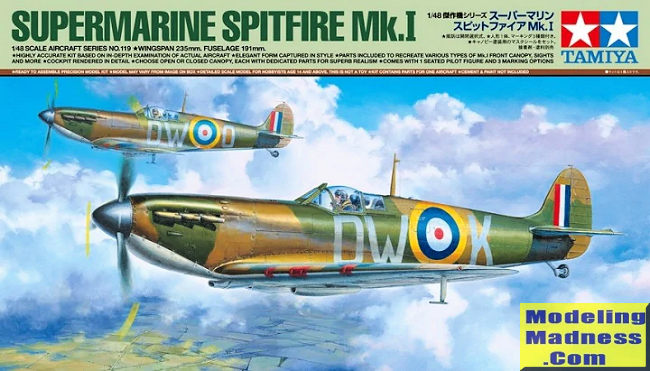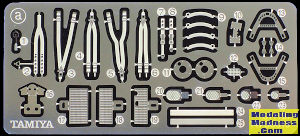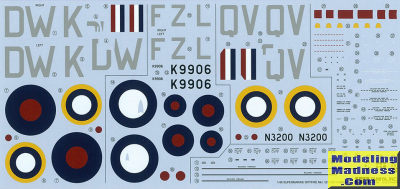
| KIT #: | 61119 |
| PRICE: | 2550 yen (about $23.00 at today's rate) plus shipping from a Japanese retailer. |
| DECALS: | Three options |
| REVIEWER: | Scott Van Aken |
| NOTES: |
2018 New tool kit |

| HISTORY |
The Supermarine Spitfire is a British single-seat fighter aircraft used by the Royal Air Force and other Allied countries before, during, and after World War II. Many variants of the Spitfire were built, using several wing configurations, and it was produced in greater numbers than any other British aircraft. It was also the only British fighter produced continuously throughout the war. The Spitfire continues to be popular among enthusiasts; nearly 60 remain airworthy, and many more are static exhibits in aviation museums throughout the world.
The Spitfire was designed as a short-range, high-performance interceptor aircraft by R. J. Mitchell, chief designer at Supermarine Aviation Works, which operated as a subsidiary of Vickers-Armstrong from 1928. Mitchell pushed the Spitfire's distinctive elliptical wing to have the thinnest possible cross-section, helping give the aircraft a higher top speed than several contemporary fighters, including the Hawker Hurricane. Mitchell continued to refine the design until his death in 1937, whereupon his colleague Joseph Smith took over as chief designer, overseeing the Spitfire's development through its multitude of variants.
During the Battle of Britain, from July to October 1940, the public perceived the Spitfire to be the main RAF fighter, though the more numerous Hurricane shouldered a greater proportion of the burden against Germany's air force, the Luftwaffe. However, Spitfire units had a lower attrition rate and a higher victory-to-loss ratio than those flying Hurricanes because of the Spitfire's higher performance. During the battle, Spitfires were generally tasked with engaging Luftwaffe fighters—mainly Messerschmitt Bf 109E-series aircraft, which were a close match for them.
| THE KIT |
 The Spitfire has reached
nearly mythical status among a lot of modelers and enthusiasts, so it was
with glad cries that the announcement of a new tool Spit I from Tamiya was
met. Now Tamiya already had this aircraft in their catalogue, but it was one
developed in the 1990s and was lacking the detail expected of modern kits
and apparently has a few shape issues as well.
The Spitfire has reached
nearly mythical status among a lot of modelers and enthusiasts, so it was
with glad cries that the announcement of a new tool Spit I from Tamiya was
met. Now Tamiya already had this aircraft in their catalogue, but it was one
developed in the 1990s and was lacking the detail expected of modern kits
and apparently has a few shape issues as well.
Apparently this one has
take n care of all those issues as I have not heard the usual fussing and whining
when something is amiss with a new kit. Indeed, the level of detail on this one
is quite extensive. In addition, there is something I've not seen in a Tamiya
kit before and that is a photo etch fret.
n care of all those issues as I have not heard the usual fussing and whining
when something is amiss with a new kit. Indeed, the level of detail on this one
is quite extensive. In addition, there is something I've not seen in a Tamiya
kit before and that is a photo etch fret.
The kit provides a number of options depending on the variation one is building. For instance, there are separate interior sidewall pieces for open and closed canopy with one having the rails and the other not. You are also provided alternate antenna masts as well as some alternate interior sidewall bits. There are separate rudder straps depending on if you want to include the pilot figure and part of the p.e. is for a seat harness. There is even a piece to temporarily install to keep the harness properly aligned.
You are provided with separate ailerons and rudder, though not flaps, which is how it should be as these were almost always raised. The landing gear is very much like on their previous 109 with both legs molded as one piece with a cross member bit. This is then covered by lower wing panels. While this ensures a correct stance, it does add to the difficulty of masking it while painting the airframe.
 The kit provides a separate
entrance door, but you will have to cut out the old one to use it. This tells me
that the demand for an open door is not that high or it would have been molded
open. Two different windscreens are also provided with one being armored. Tamiya
provides paper cut out masks for the clear bits.
The kit provides a separate
entrance door, but you will have to cut out the old one to use it. This tells me
that the demand for an open door is not that high or it would have been molded
open. Two different windscreens are also provided with one being armored. Tamiya
provides paper cut out masks for the clear bits.
Instructions use Tamiya-only paint references, but most of us have access to the standard camo of the time. All options have the Dark Green/Dark Earth upper camouflage pattern. One is the box art plane from 610 Squadron with sky undersides. Another is from 69 Squadron in prewar markings with a silver underside. The third has black/white wing undersides with the rest in silver. This is from 19 Squadron. Tamiya's full color painting and markings guide does differentiate between the A and B upper camouflage pattern. The decals are very nicely printed and based on experience with their newer markings, should work just great.
| CONCLUSION |
| REFERENCES |
https://en.wikipedia.org/wiki/Supermarine_Spitfire
January 2019
Copyright ModelingMadness.com. All rights reserved
This kit courtesy of my wallet.
If you would like your product reviewed fairly and fairly quickly, please contact the editor or see other details in the Note to Contributors.
Back to the Main Page Back to the Review Index Page Back to the Previews Index Page